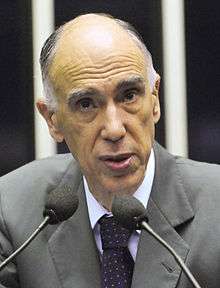Marco Maciel
| His Excellency Marco Maciel | |
|---|---|
 | |
| 22nd Vice President of Brazil | |
|
In office 1 January 1995 – 1 January 2003 | |
| President | Fernando Henrique Cardoso |
| Preceded by | Itamar Franco |
| Succeeded by | José Alencar |
| Chief of Staff of the Presidency | |
|
In office 14 February 1986 – 30 April 1987 | |
| President | José Sarney |
| Preceded by | José Hugo |
| Succeeded by | Ronaldo Couto |
| Minister of Education | |
|
In office 15 March 1985 – 14 February 1986 | |
| President | José Sarney |
| Preceded by | Esther Ferraz |
| Succeeded by | Jorge Bornhausen |
| 45th Governor of Pernambuco | |
|
In office 15 March 1979 – 15 May 1982 | |
| Vice Governor | Roberto Magalhães |
| Preceded by | Moura Cavalcanti |
| Succeeded by | José Muniz Ramos |
| President of the Chamber of Deputies | |
|
In office 1 February 1977 – 1 February 1979 | |
| Preceded by | Célio Borja |
| Succeeded by | Flávio Marcílio |
| Personal details | |
| Born |
21 July 1940 Recife, Pernambuco, Brazil |
| Nationality | Brazilian |
| Political party |
ARENA (1966–1979) PDS (1980–1984) PFL (1985–2007) DEM (2007–present) |
| Spouse(s) | Ana Maria Maciel |
| Profession | Lawyer and Professor |
| Religion | Roman Catholic[1] |
Marco Antônio de Oliveira Maciel (born Recife, 21 July 1940) is a Brazilian politician, lawyer and law school professor who served as the 22nd Vice President of Brazil from 1 January 1995 to 1 January 2003, twice elected [2] on the same ticket as center-left President Fernando Henrique Cardoso in the 1994 and 1998 general elections. He was a founder of the conservative PFL party, former ARENA.
Before vice presidency he was chairman of the Chamber of Deputies (1977–1979), Governor of Pernambuco (1979 and 1982), Minister of Education (1985–1986) and Chief of President Sarney's cabinet (1986–1987). Maciel returned to the Senate following his Vice Presidency, until he was defeated in 2010.
Personal life
Marco Maciel is married to Ana Maria Maciel and has three sons, he is also a practising Roman Catholic.[3]
References
- ↑
- ↑ "Brazil's new Embraer 70-seat jet rivals small Boeing, Airbus planes". Waterloo Region Record. 30 October 2001. p. C8. Retrieved 8 March 2011.
- ↑
External links
| Political offices | ||
|---|---|---|
| Preceded by Itamar Franco |
Vice President of Brazil 1995–2003 |
Succeeded by José Alencar |

